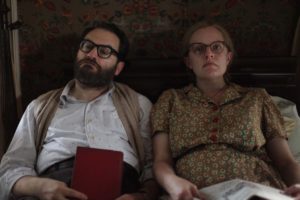Film Review: The Gothic Pleasures of “Shirley” Are Mixed
Written by: Christopher Llewellyn Reed | June 4th, 2020

Shirley (Josephine Decker, 2020) 2½ out of 4 stars.
As much fictionalized biopic of one important moment in the late author Shirley Jackson’s life as homage to Edward Albee’s seminal 1962 play Who’s Afraid of Virginia Woolf, Josephine Decker’s latest film, Shirley, casts Elisabeth Moss (The Invisible Man) in the title role, all bitterness, bile and bite. Her codependent marriage to literary critic, and Bennington College professor, Stanley Hyman (Michael Stuhlbarg, The Shape of Water) provides the vicious backdrop for this sometimes probing tale of writerly inspiration punctuated by twisted, gothic beats. Unfortunately, not all elements of mise-en-scène and performance fall into harmonious place with the narrative, making of the movie a flawed, if still interesting, imagining of Jackson’s life of the mind.
Decker (Madeline’s Madeline) opens on a young couple, Fred (Logan Lerman, End of Sentence) and Rose (Odessa Young, Assassination Nation), on their way to a new teaching post for the former, who is slated to work under Hyman’s tutelage. Rose is pregnant, and they seem very much in love and still hot for each other, at least based on the train sex in which they engage on their way to Vermont. Once there, they find the Hyman-Jackson home in full party mode, though one member of the couple is so consumed by depression that all she can do is drink, spit out nasty one-liners and take to her bed. Hyman, on the other hand, is all gregarious bonhomie. He’s also a controlling misogynist and philanderer. My, what a lovely couple he and Jackson make!

Fred and Rose are creations of Susan Scarf Merrell, from whose eponymous 2014 novel the film is adapted by screenwriter Sarah Gubbins (I Love Dick). Their main purpose is to serve as foils to the older couple’s manipulative ways. As Fred becomes more engrossed in his academic duties (and, maybe, in his young female students), Rose is left increasingly alone with Jackson, who sees her first as an annoyance, then stand-in for the protagonist of a new novel she is writing (what will eventually become the 1951 Hangsaman), then muse and, perhaps, lover (real or fantasized about).
At this point in her career, Jackson’s main claim to fame was her recently published short story “The Lottery,” a parable of mob rule, ethnic cleansing, and the human tendency to sacrifice individuals on the altar of social order. It’s still one of the things she is most famous for (I remember reading it in school), though the 1959 The Haunting of Hill House is another perennial favorite. Sadly, while Shirley explores Jackson’s intense preoccupation with female agency (a major focus of Hangsaman), it does not effectively communicate who Jackson is beyond either that one issue (as important as it is) or her depression.

And so we are left with a muddy appreciation, suitably photographed in brownish tones, where the usually reliable Stuhlbarg overplays his part while Moss sulks in sullen silences punctuated by occasional nasty barbs. Lerman is wasted in his own role as a feckless fool, though Young shines, as best she can, as a young woman just finding her way. There is none of the energy of the best bits of Jackson’s writing, only the dread. Still, that’s enough to keep us watching. Imperfect though it may be, Shirley nevertheless offers enough of an appreciation of what makes Jackson special to warrant some appreciation of its own.

